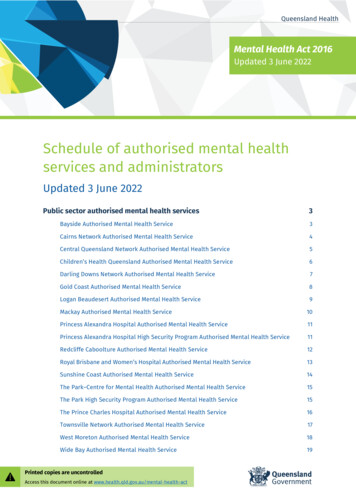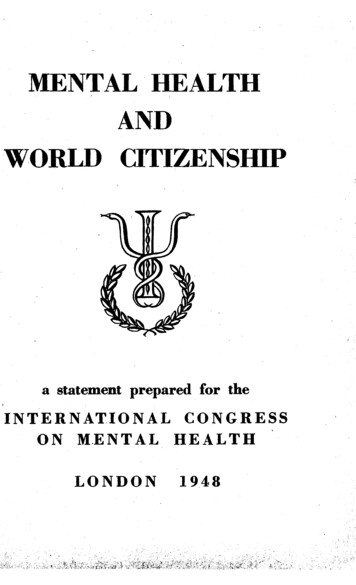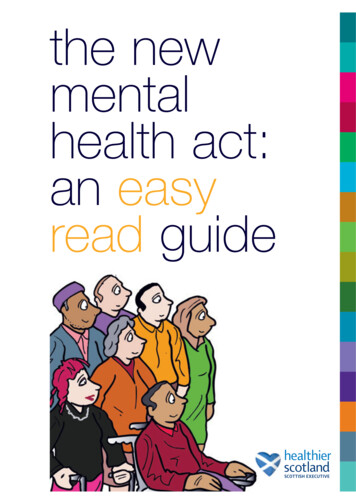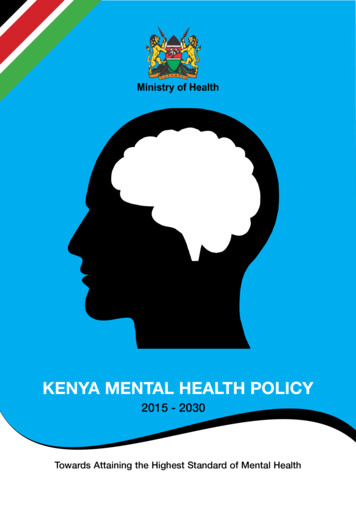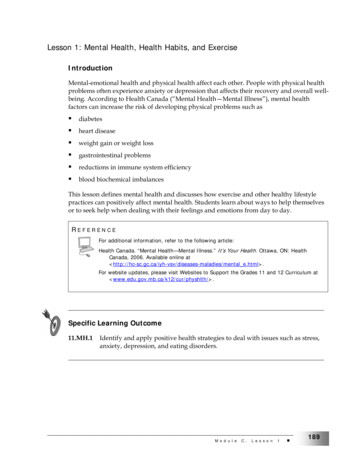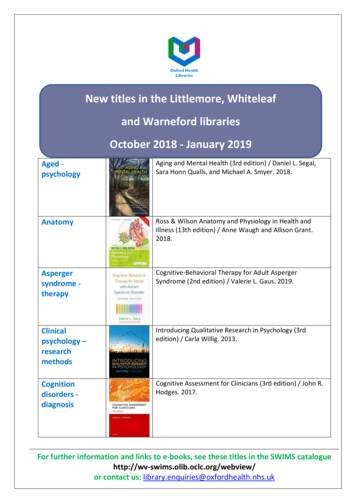
Transcription
FAQS ABOUT MENTAL HEALTH AND SUBSTANCEUSE DISORDER PARITY IMPLEMENTATION AND THECONSOLIDATED APPROPRIATIONS ACT, 2021 PART 45April 2, 2021The Consolidated Appropriations Act, 2021 (the Appropriations Act) amended the Mental Health Parityand Addiction Equity Act of 2008 (MHPAEA) to provide important new protections. The Departments ofLabor (DOL), Health and Human Services (HHS), and the Treasury (collectively, “the Departments”) havejointly prepared this document to help stakeholders understand these amendments. Previously issuedFrequently Asked Questions (FAQs) related to MHPAEA are available erparity and d-faqs#Mental Health Parity.Mental Health Parity and Addiction Equity Act of 2008MHPAEA generally provides that financial requirements (such as coinsurance and copays) and treatmentlimitations (such as visit limits) imposed on mental health or substance use disorder (MH/SUD) benefitscannot be more restrictive than the predominant financial requirements and treatment limitations that applyto substantially all medical/surgical benefits in a classification. 1 In addition, MHPAEA prohibits separatetreatment limitations that apply only to MH/SUD benefits. MHPAEA also imposes several importantdisclosure requirements on group health plans and health insurance issuers.The MHPAEA final regulations require that a group health plan or health insurance issuer may not impose anon-quantitative treatment limitation (NQTL) with respect to MH/SUD benefits in any classification unless,under the terms of the plan (or health insurance coverage) as written and in operation, any processes,strategies, evidentiary standards, or other factors used in applying the NQTL to MH/SUD benefits in theclassification are comparable to, and are applied no more stringently than, the processes, strategies,evidentiary standards, or other factors used in applying the limitation to medical/surgical benefits in thesame classification. 2 Under this analysis, the focus is not on whether the final result is the same forMH/SUD benefits as for medical/surgical benefits, but rather on whether the underlying processes,strategies, evidentiary standards, and other factors are in parity. These processes, strategies, evidentiarystandards, and other factors must be comparable and applied no more stringently for MH/SUD benefits thanfor medical/surgical benefits.Since the enactment of MHPAEA, the Departments have issued guidance and compliance assistancematerials to help stakeholders understand the law and its implementing regulations, including therequirements for NQTLs. Most recently, in September 2019, the Departments issued Final FAQs part 39. 3In an effort to promote compliance, the FAQs provided additional examples regarding how the NQTLrequirements in the MHPAEA final regulations apply to different fact patterns.The DOL also maintains on its website a MHPAEA Self-Compliance Tool that is intended to help grouphealth plan sponsors and administrators, health insurance issuers, State regulators, and other stakeholdersdetermine whether a group health plan or health insurance issuer complies with MHPAEA. 4 The MHPAEAThe six classifications of benefits defined in final regulations implementing the requirements of MHPAEA are: (1) inpatient, innetwork; (2) inpatient, out-of-network; (3) outpatient, in-network; (4) outpatient, out-of-network; (5) emergency care; and (6)prescription drugs. 26 CFR 54.9812-1(c)(2)(ii); 29 CFR 2590.712(c)(2)(ii); and 45 CFR 146.136(c)(2)(ii).2 26 CFR 54.9812-1(c)(4)(i); 29 CFR 2590.712(c)(4)(i); and 45 CFR 146.136(c)(4)(i) and 147.160.3 FAQs about Mental Health and Substance Use Disorder Parity Implementation and the 21st Century Cures Act Part 39 (Sept. 5,2019), available at 39-final.pdfand d-FAQs/Downloads/FAQs-Part-39.pdf.4 2020 MHPAEA Self-Compliance Tool, available at iance-tool.pdf.1
Self-Compliance Tool includes a section on NQTLs that outlines a process for conducting comparativeanalyses of NQTLs. The MHPAEA Self-Compliance Tool is updated every two years and was mostrecently updated in 2020 by the DOL (in coordination with the Department of the Treasury and HHS).The Consolidated Appropriations Act, 2021The Consolidated Appropriations Act, 2021 was enacted on December 27, 2020. 5 Section 203 of Title II ofDivision BB of the Appropriations Act amended MHPAEA, in part, by expressly requiring group healthplans and health insurance issuers offering group or individual health insurance coverage that offer bothmedical/surgical benefits and MH/SUD benefits and that impose NQTLs on MH/SUD benefits to performand document their comparative analyses of the design and application of NQTLs. Further, beginning 45days after the date of enactment of the Appropriations Act, these plans and issuers must make theircomparative analyses available to the Departments or applicable State authorities, upon request, includingthe following information:1.The specific plan or coverage terms or other relevant terms regarding the NQTLs and a descriptionof all MH/SUD and medical or surgical benefits to which each such term applies in each respectivebenefits classification;2.The factors used to determine that the NQTLs will apply to MH/SUD benefits and medical orsurgical benefits;3.The evidentiary standards used for the factors identified, when applicable, provided that everyfactor shall be defined, and any other source or evidence relied upon to design and apply theNQTLs to MH/SUD benefits and medical or surgical benefits;4.The comparative analyses demonstrating that the processes, strategies, evidentiary standards, andother factors used to apply the NQTLs to MH/SUD benefits, as written and in operation, arecomparable to, and are applied no more stringently than, the processes, strategies, evidentiarystandards, and other factors used to apply the NQTLs to medical/surgical benefits in the benefitsclassification; and5.The specific findings and conclusions reached by the plan or issuer, including any results of theanalyses that indicate that the plan or coverage is or is not in compliance with the MHPAEArequirements. 6The Appropriations Act also provides that the Departments shall request that a group health plan or issuersubmit the comparative analyses for plans that involve potential MHPAEA violations or complaintsregarding noncompliance with MHPAEA that concern NQTLs, and any other instances in which theDepartments determine appropriate. 7The Appropriations Act further requires the Departments, after review of the comparative analyses, to shareinformation on findings of compliance and noncompliance with the State where the plan is located or theState where the issuer is licensed to do business. Additionally, not later than one year after enactment of theAppropriations Act and annually by October 1 thereafter, the Departments must submit to Congress andmake publicly available a report that sets forth:1. A summary of the comparative analyses requested, including the identity of each plan or issuer thatis determined not to be in compliance after a final determination;Pub. L. 116-260 (Dec. 27, 2020).Internal Revenue Code (Code) section 9812(a)(8)(A)(i)-(iv), ERISA Section 712(a)(8)(A)(i)-(iv) and Public Health Service (PHS)Act section 2726(a)(8)(A)(i)-(iv).7 Code section 9812(a)(8)(B)(i), ERISA section 712(a)(8)(B)(i), and PHS Act section 2726(a)(8)(B)(i).562
2. The Departments’ conclusions as to whether each plan or issuer submitted sufficient informationfor the Departments to review the comparative analyses requested;3. For each plan or issuer that submitted sufficient information for the Departments to review thecomparative analyses requested, the Departments’ conclusion as to
MH/SUD benefits as for medical/surgical benefits, but rather on whether the underlying processes, strategies, evidentiary standards, and other factors are in parity. These processes, strategies, evidentiary standards, and other factors must be comparable and applied no more stringently for MH/SUD benefits than for medical/surgical benefits.

